SWEDISH SOUTH ASIAN STUDIES NETWORK
Department of Land and Water Resources Engineering; School of Architecture and the Built Environment, Royal Institute of Technology (KTH), Stockholm: |
Postal address: Institutionen för mark och vattenteknik,
KTH, SE-100 44 Stockholm, Sweden
Visiting address: Teknikringen 76
Fax: +46-8-411 0775
Web page: http://www.lwr.kth.se/english/Index.htm
Contact persons:
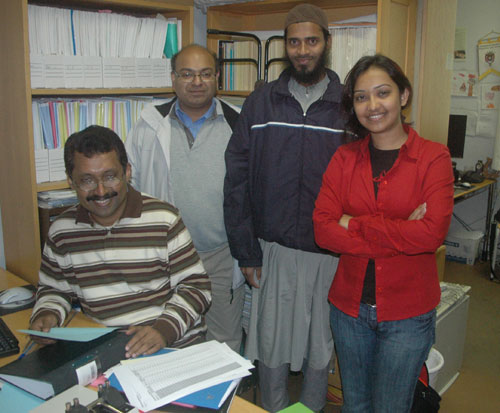 |
| Researchers and students at the department. From left to right: PhD Candidate Mohammed Hossain, University of Dhaka; Prof. Prosun Bhattacharya; and the Linnaeus Palme exchange programme scholarship students Sarmin Sultana and Mokleksur Rahman, both from the University of Dhaka, Bangladesh. |
• Professor Prosun
Bhattacharya, phone: + 46 (0)8 790 73 99.
Personal web page: http://www.lwr.kth.se/Personal/personer/
bhattacharya_prosun/index.htm
• Professor Emeritus Gunnar
Jacks, phone: +46 (0)8 790 7380
Research fields connected to South Asia:
‡ Arsenic in groundwater in Bangladesh and India
‡ Fluoride in groundwater in India
‡ Local water supply and sanitation in suburban Dhaka, Bangladesh
‡ Heavy metal pollution in groundwater in Punjab
‡ Groundwater Quality in Southern India
Partner university research departments in South Asia
• Dept. of Geology, University of Dhaka – prof
Kazi Matin Ahmed
• Dept. of Chemistry, Kalyani
University, West Bengal, India – prof. Debashis
Chatterjee
• The Central Ground Water
Board of India
• Arsenic Research Group, NGO, Dhaka – Dr Arif
Mohiuddin Sikhder
• Dept. of Geology, Panjab University,
Chandigarh, India – prof K P Singh
• Water Technology Centre, Tamil
Nadu Agricultural University – prof K
Palanisami
Linnaeus Palme Exchange Programme
The department is involved in a teachers and students exchange
with the Department of Geology at Dhaka University, Bangladesh through the Linnaeus Palme
Exchange Programme. Prosun Bhattacharya is the key person on the Swedish
side, and Prof. Kazi Matin Ahmed
on the Bangladeshi side. A Linnaeus Palme Exchange Programme grant was first given in 2004-05.
Since 2008, the department is also involved in a Linnaus Palme exchange programme with the National Law School of India University (NLSIU) in Bangalore, India.
Both projects have received continued funding for the period 2009-10. More information about the South Asia related Linnaeus Palme projects for 2009-10. ![]()
Research connected to South Asia:
Professor Emeritus Gunnar
Jacks has been engaged in research on water issues
in South India since the late 1960’s, when he first visited Coimbatore
in Tamil Nadu and established a long-standing relation with Tamil
Nadu Agricultural University. Over the decades a large number of students
from the Dept. of Land and Water Resources Engineering at KTH have gone
to Coimbatore to do field work for theses.
Prof. Jacks is still involved with a major water resources management
project in South India, in collaboration with the Department of Water
and Environmental Studies, Linköping University, and SACIWaters,
Hyderabad, India. More information on this
project.
Gunnar Jacks graduated as a mining engineer from KTH in 1963. After working with rock stability
issues for a couple of years he and his wife Birgitta spent a year with a humanitarian Non-Governmental
Organization (NGO) in Turkey where he realized the importance of water for societies and human
life. He took a B. Sc. degree in Medicine from the Karolinska Institutet, Stockholm in 1971. After
returning to Sweden and KTH, he studied hydrology and received the PhD in hydrochemistry in
1973.
A turning point was when he assisted his professor in a short term groundwater investigation
in Tamil Nadu, India. That led to a three year project work within Central Ground Water Board in
Coimbatore in India and later on to an engagement in a project in Kerala, India. The chemistry of
fluoride in groundwater was a major subject of his research interest and together with his Indian
colleagues, he has published a number of research articles. While he has throughout years been a
faculty member at KTH he has been on missions to Botswana, Vietnam, Thailand, and Laos.
In 1985, he got a professorship in Groundwater
Chemistry. He took a very active part in teaching and research on
acidification of soil and groundwater during the 1980s and 1990s. The quantitative study of weathering
rates became an important issue and he was part of a group that used strontium isotopes for
assessments. During this period he was also doing research on artificial recharge of groundwater
as well as wetland hydrology and hydrochemistry. He has been involved with a number of international
research projects since 1990s which include investigation on high fluoride groundwater
in Rajasthan, India (1994–1997), and local water supply and sanitation in suburban
Dhaka, Bangladesh (1999–2003).
He has supervised
a significant number of PhD students during his professional career at the KTH and serve as a
peer-reviewer in a number of scientific committees and peer-reviewed journals.
Professor Jacks been actively involved in research on arsenic in soil and groundwater systems
since 1991. During 1996, his research group at KTH was contacted by Dr. Debashis Chatterjee from the Kalyani University situated near Kolkata, India regarding the arsenic problems in West
Bengal. That was the start of a still ongoing work in India, Bangladesh and several other parts
of the world with a principal focus on research on the mechanisms of arsenic mobilization in
groundwater environments, a work now headed by Prof. Dr. Prosun Bhattacharya (more information below).
Gunnar Jacks is a guest professor at Åbo Akademi University, the Swedish speaking university in Finland. In
2006, he was elected as the President of the International Society of Groundwater for Sustainable
Development (ISGSD). Gunnar Jacks was also instrumental in setting up of SASNET, and was a member
of the SASNET board till 2003.
He presented his research on ”Water
supply – from the source to the mouth” at the Swedish
Development Studies research conference, named ”Fattiga och rika.
Aktuell utvecklingsforskning och dess villkor i Sverige”, organised
by Sida/SAREC and Lund University on 9–11 January 2003. Read
the abstract.
Jacks also organised a panel at the 18th European Conference on Modern
South Asian Studies organised by SASNET and Lund University in July 2004.
The panel was named ”Industrialisation in
South Asia – economic, social and environmental aspects”. Full information on the panel.
In November 2005 Prof. Jacks received a one-year research grant from Sida/SAREC
for a project titeld ”Risk for sea
water intrusion in the Kerala coastal aquifers”.
The other partners in the project are Mattias von
Brömssen at the same department; plus Warrier C. Unnikrishnan, and P. S. Harikumar from the Centre
for Water Resources Development and Management (CWRDM), Kozhikode, Kerala,
India. The cooperation with CWRDM is set to continue from October 2008 with the investigation of groundwater around Vembanad Lake and its connection with the brackish estuary. ![]()
Project abstract: Kerala Coastal aquifers on the SW part
of the Indian peninsula range from Tertiary to Holocene in age. The Tertiary
aquifers are found in the coastal sediments formed when the Indian peninsula
was largely drained westwards. The deeper aquifers have a sequence from
the south of calcium -bicarbonate water via sodium-bicarbonate water to
a brackish water in the north. The fresh aquifers are subject to overdraft
with risk of salt water intrusion. However, the presence of sodium-bicarbonate
water indicates flushing out of a former saline/brackish water. The hypothesis
is that thios reflects flushing during glacial times when the sea water
level was 125 m below the present one. The project aims at dating the groundwater.
If the hypothesis is verified the risk for sea water intrusion is less
alarming as the salt water/fresh water interface might be off-shore.
In August 2006, Prof. Jacks was given
SEK 20 000 as a SASNET grant to cover a guest lecture programme
to bring Dr. Alagappan
Ramanathan, Dept. of Environmental Sciences, Jawaharlal Nehru University (JNU),
New Delhi, India, to Sweden (more
information about the SASNET grants 2006).
In
November 2007, Prof. Jacks was given SEK 600 000 as a three-years grant (2008-10) from Sida's
Developing Country Research Council (U-landsforskningsrådet), for a project titled ”Fluoride contamination in groundwater (Karnataka, India): A
community effort in cost-affective treatment and management”. The project is a cooperation between Associate Professor Joyanthi Routh at the department of Geology and Geochemistry, Stockholm University, and Professor B.S. Choudri at TERI Institute, Goa, India. More information about the Sida grants 2007.
Prof. Jacks is also involve din a research project on ”System for Rice Intensification – saving water and producing more?” in collaboration with Dr.
Nilanjan Ghosh from the MCX Academy for Commodity Research (MACOR) in Mumbai, India. At the Sida-funded conference on current Swedish development research titled ”Meeting Global Challenges in Research Cooperation” that was jointly organised by Uppsala Uppsala University and the Swedish University of Agricultural Sciences (SLU) in Uppsala 27–29 May 2008 (more information), Prof. Persson presented a paper on the project in a panel on ”Sustainable, productive and efficient agriculture – an impossible match?”.
Abstract: Rice is the staple food for a large fraction of the global population. Wetland rice requires about
1 200-1 400 mm of water per crop. However, in the early 1990s Father Henri de Laulanie,
engaged in rice cultivation on Madagascar, published his experiences from a drought period when
the lowland rice could not be kept flooded (Laulanie, 1993). He found that the yield increased
although the applied irrigation water was only about half the conventional amount. This
interesting finding has initiated experiments especially in Asia, in China and India notably.
There has been harsh criticism against the practice using words such as
nonsense and no science. The growing experience in the practise both supports the claim that
yields are higher and
denies it. Several advantages are registered like a better nitrogen
economy as denitrification decreases. Further, emissions of greenhouse gases
like dinitrogen oxide and methane decrease. What has further been debated
is the labour requirement. SRI uses a different planting pattern and requires more frequent
mechanical weeding. Adopting the practise requires considerable extension
work and regard to seasonal financial constraints for poor farmers.
The advantages documented regarding water efficiency, nitrogen economy, environmental impact
and returns for the farmers indicate that SRI is a promising practise
especially where water is a constraint. It seems that a successful adoption requires a considerable
extension work.
 Research
projects by the KTH-International Groundwater Arsenic Research Group, GARG
Research
projects by the KTH-International Groundwater Arsenic Research Group, GARG
A
separate KTH-International Groundwater
Arsenic Research Group, GARG (Forskargruppen för miljögeokemi)
within the department is studying contaminated groundwaters and soils.
GARG is presently engaged in research projects concerning the arsenic
problem in the Bengal Delta Plain. Some of these studies deal with arsenic
in groundwater, which is a very serious problem to inhabitants of the
Indian state of West Bengal, and Bangladesh. In these areas some 33 million
inhabitants are using arsenic-contaminated water daily; about 200,000
of them are displaying symptoms of arsenic poisoning.
The main research issues are to find out how the arsenic in the sediments
is dissolved and gets into the groundwater, and the methods for the removal
of arsenic. Before remediation methods are put into practice, investigation
of their long-term implications are made, as well as which chemical constituents
in the groundwater may affect the different methods of arsenic removal.
One of the major targets is to develop low-cost and sustainable methods
for the removal of arsenic from contaminated water. They should be viable
on a small scale, to be used in villages or small communities. Further,
GARG studies the groundwater composition from different aquifers of
Bangladesh, which will serve as a basis for finding arsenic-safe groundwater
sources for sustainable drinking water supply. More
information on GARG.
The arsenic research carried out has been funded by Sida/SAREC, and the United Nations Children’s Emergency Fund (UNICEF) during the period 1999–2006, and the Swedish Strategic Environmental Research Foundation (Mistra) for the period 2006–2009.
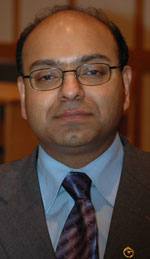
Professor Prosun Bhattacharya (photo to the left) is the leading researcher at the department presently engaged in research projects on arseniferous groundwater in India and Bangladesh.
Basic research is going on. The current work is still partly in the stage of characterizing the aquifers, from which arsenic is mobilized. A relation that has been confirmed is that groundwater contains a significant quantity of dissolved iron, a fact that is related to its high levels of arsenic. The chemical environment in the delta sediment often makes the ferric oxides, i e rust, to dissolve and thereby mobilizes arsenic, which is adsorbed to the oxides. This means that water containing much arsenic may be remediated. One method is to add oxygen to the water; this makes the iron precipitate as ferric oxide, which will then adsorb the arsenic on its surfaces, making the water drinkable. Another method now employed is to mix laterite, a kind of soil available in large quantities in West Bengal, with the water. This binds some 80 to 90 per cent of the arsenic in soil.
Arsenic
in groundwater of Bangladesh and India has been focus
for research at the department for several years. They have tried to
find out why groundwater in certain parts of Bangladesh and adjacent
areas are contaminated while others are not. The sediments, i e the
soil layers, are also being examined. Obviously, the geological features
as well as the changes of the chemical environment determine the contents
of arsenic; it has already been found that younger, more shallow layers
contain more arsenic than older, deeper ones do. This explains why groundwater
from more shallow wells do contain more arsenic than deeper ones. Consequently,
one solution would be to drill deeper wells.
Other projects have focused on mapping the acquifers
(groundwater-carrying sediment layers) with an aim at making it easier
to find where existing wells can be drilled deeper in order to reach
aquifers where the arsenic content is lower.
Arsenic-contaminated water in different parts of the world. The research in Bangladesh
and West Bengal will also result in knowledge that may be used in other areas
with arsenic-contaminated waters as well. Two of these are the Huhhot Alluvial
Basin of inner Mongolia and the Chaco-Pampas Plains of the Argentine. Alarming
reports about arsenic-contaminated waters are also coming from China, Thailand,
Vietnam and Taiwan; evidently, the development of sustainable methods to purify
contaminated groundwaters is urgent.
GARG projects 1997–2007:
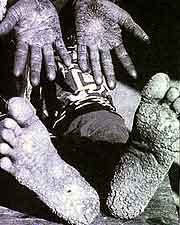 • Arseniferous groundwater in West
Bengal-processes of formation and possible remediation. Research
project funded by SAREC, Sida 1997-1999. Participating Scientists: Gunnar Jacks and Prosun
Bhattacharya
• Arseniferous groundwater in West
Bengal-processes of formation and possible remediation. Research
project funded by SAREC, Sida 1997-1999. Participating Scientists: Gunnar Jacks and Prosun
Bhattacharya
• Mechanistic appraisal of arsenic mobilization from the alluvial aquifer sediments: A case study of arsenic contaminated groundwater in the Bengal Delta Plains in India and Bangladesh. Research project funded by Swedish Natural Sciences Research Council (NFR) 1998-2000. Participating Scientists: Gunnar Jacks, Prosun Bhattacharya, Jon Petter Gustafsson , Andre Sracek, and Debashis Chatterjee (Dept. of Chemistry, Kalyani University, India).
• Remediation of Arseniferous groundwater by Artificial Recharge-West Bengal, India. Research project funded by Åke and Greta Lissheds Foundation, Stockholm 1998-1999. Participating Scientists: Gunnar Jacks, and Prosun Bhattacharya.
• Mechanisms of mobilization of arsenic in sedimentary aquifers in West Bengal and Realistic approach for in-situ remediation methods. Research project funded by Rajiv Gandhi National Drinking Water Mission, Department of Rural Development, Ministry of Rural Areas and Employment, Government of India. 1998-2001. Principal Investigator: D. Chatterjee, Department of Chemistry, University of Kalyani, India. Co-investigators: Gunnar Jacks, and Prosun Bhattacharya.
• High-Arsenic Groundwater in the Alluvial Aquifers of Bengal Delta Plains in Bangladesh: Genesis and Low-Cost Remediation. Research project funded by SAREC, Sida 1999-2002. Participating Scientists: Prosun Bhattacharya, Gunnar Jacks, Bo Olofsson, Jaana Aaltonen, Aftab Alam Khan, Kazi Matin Ahmed, S. Humayun Akhtar, M. Aziz Hasan.
• Arsenic in the Bengal Delta Plain Groundwaters in West Bengal (India) – Genesis and Mitigation Aspects: An interdisciplinary research proposal for investigating arsenic contamination in groundwater and remediation strategies. Sida/SAREC planning project 2002. Participating Scientists: PhD Joyanto Routh (from the Section for Biogeochemistry; Dept of Geology and Geochemistry, Stockholm University), Prosun Bhattacharya, Gunnar Jacks, S.P. Sinha Ray, and S.K. Nag.
• The project Options for safe drinking water in regions with high arsenic groundwater in Bangladesh aimed at evaluating different methods of purifying arsenic-contaminated water to make it suitable as drinking-water. Geophysical, geochemical as well as hydrogeological approaches are applied in this work. During a two-year period a multitude of data for this purpose is going to be collected, and water samples analysed. The project was financed by a Swedish Research Links grant given in December 2003, for a three-years project. See full list of Swedish Research Links grants for the period 2004-06.
• In August 2005 Dr. Bhattacharya received a SASNET Planning grant for a research project titled ”Arsenic contamination in groundwater in South Asia, and sustainable drinking water options.” More information. The project was carried out in collaboration with Prof. Dr. A.L. Ramanthan at the School of Environmental Sciences, Jawaharlal Nehru University (JNU), New Delhi, India. Prof. Ramanthan visited KTH in July 2006 as a visiting scientist within this research project. During the visit in Sweden Dr. Bhattacharya and Prof. Tamanthan then formulated a joint research strategy for sustainable drinking water options in the Central Gangetice Plains of India.
Projects from 2006
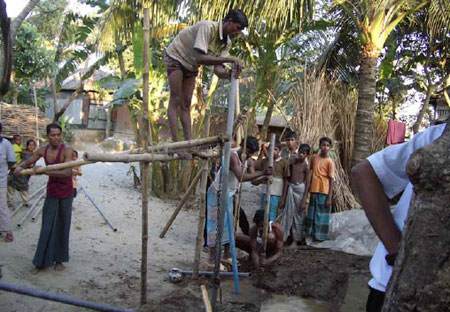 In
April 2006, Dr. Bhattacharya and his colleague Associate Professor Roger Thunvik, received SEK 3.65 million as a grant from the Swedish Foundation for Strategic Environmental Research (Mistra) for innovative environmental research (”idestöd”), for a project titled ”Targeting safe aquifers in regions with high arsenic groundwater and its
worldwide implications”. The project was
managed through a project group, also including Professor Kazi Matin Ahmed at Dhaka
University in Bangladesh, Prof. Jochen
Bundschuh at Instituto Costarricense de
Electricidad in Costa Rica, Prof. Gunnar
Jacks,
Dr. Gunaratna, M.Sc Mattias von Brömssen, Dr. Md Jakariya at NGO Forum for
Drinking Water and Sanitation in Bangladesh,
and M.Sc. Md Aziz Hasan at Dhaka
University.
In
April 2006, Dr. Bhattacharya and his colleague Associate Professor Roger Thunvik, received SEK 3.65 million as a grant from the Swedish Foundation for Strategic Environmental Research (Mistra) for innovative environmental research (”idestöd”), for a project titled ”Targeting safe aquifers in regions with high arsenic groundwater and its
worldwide implications”. The project was
managed through a project group, also including Professor Kazi Matin Ahmed at Dhaka
University in Bangladesh, Prof. Jochen
Bundschuh at Instituto Costarricense de
Electricidad in Costa Rica, Prof. Gunnar
Jacks,
Dr. Gunaratna, M.Sc Mattias von Brömssen, Dr. Md Jakariya at NGO Forum for
Drinking Water and Sanitation in Bangladesh,
and M.Sc. Md Aziz Hasan at Dhaka
University.
Later the same year, in October 2006, Dr. Bhattacharya received another SEK 600 000 as a three-years
grant (2007-09) from the Swedish Research Links programme (funded by
Sida and the Swedish Research Council) for a similar project titled ”Targeting
safe aquifers in regions with high arsenic in groundwaters of India and
the options for sustainable drinking water supply”. More
information about the project, with an abstract.
The scientists involved in this project included (besides Prof. Prosun Bhattacharya himself, and Roger Thunvik from the KTH-Groundwater Arsenic Research Group), Dr. K.R. Gunaratna, Dept. of Environmental Microbiology, KTH; Prof. Al. Ramanathan from the School of Environmental Sciences, Jawaharlal Nehru University (JNU), New Delhi, India; Prof. Chandan Mahanta, Indian Institute of Technology (IIT), Guwahati, India; and Dr. D. Chandrashekharam, Department of Earth Sciences, Indian Institute of Technology (IIT) Bombay, India.
In June 2007, Prof. Prosun Bhattacharya received SEK 909.900 for a three-years project (2008-10) titled ”Groundwater arsenic in Chhattisgarh, Central India and options for sustainable arsenic-safe drinking water supplies”, as a Joint Formas–SAREC grant for research on sustainable development in developing countries. The grant is jointly provided by the Swedish Research Council for Environment, Agricultural Sciences and Spatial Planning (FORMAS), and the Department for Research Cooperation (SAREC) within the Swedish International Development Cooperation Agency (Sida). The project will be carried out in collaboration between the KTH-International Groundwater Research Group, and Pandit Ravi Shankar Shukla University (PRSU) in Raipur, Chattisgarh state, India. The project coordinator on the Indian side is Professor K.S. Patel, School of Studies in Chemistry, PRSU.
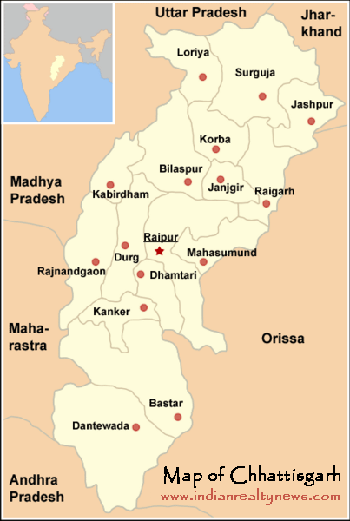 Project Summary: Groundwater is the main source of potable water for the population in South Asia. In India, the presence of arsenic (As) above the limits of safe drinking water (10 μg/L) detected in groundwater widely over the Indian subcontinent has posed to be a potential source of environmental health disaster. The presence of As in the groundwater of the hard rocks aquifers in the district of Rajnandgaon in Chhattisgarh state has exposed an estimated population of 1-2 million to a potential risk of arsenic exposure. Arsenic contamination in tube-well water in Ambagarh-Chowki block in Chhattisgarh state of central India, is restricted to local areas confined within the N-S trending Dongargarh rift zone. Affected areas are preferentially located in acid volcanics, close to shear zones. As preferentially occurs in iron-enriched soil and similarly altered biotite, chlorite in granite. Pyrite in volcanic and shear zone rocks, although locally As-bearing also acts as a source of As in groundwater.
Project Summary: Groundwater is the main source of potable water for the population in South Asia. In India, the presence of arsenic (As) above the limits of safe drinking water (10 μg/L) detected in groundwater widely over the Indian subcontinent has posed to be a potential source of environmental health disaster. The presence of As in the groundwater of the hard rocks aquifers in the district of Rajnandgaon in Chhattisgarh state has exposed an estimated population of 1-2 million to a potential risk of arsenic exposure. Arsenic contamination in tube-well water in Ambagarh-Chowki block in Chhattisgarh state of central India, is restricted to local areas confined within the N-S trending Dongargarh rift zone. Affected areas are preferentially located in acid volcanics, close to shear zones. As preferentially occurs in iron-enriched soil and similarly altered biotite, chlorite in granite. Pyrite in volcanic and shear zone rocks, although locally As-bearing also acts as a source of As in groundwater.
The overall objective of the present project is to consolidate the information and database on the groundwater resources for exploitation of safe-drinking water in As affected hotspots in selected areas of Rajnandgaon district in Central India. The specific goal of this project is to develop the options for targeting As-safe aquifers for drinking purposes that involves detailed evaluation of the local geological and hydrogeological setting in order to: i) identify geological and Hydrogeological baseline study in the region, and ii) to provide and develop common scientific database on baseline hydrogeochemistry of the aquifers for the identification of As-safe and targeting the As-safe aquifers for drinking water supply. Within the framework of this project, we also aim to use the hydrogeological and geochemical constraints in the hot-spot areas as a basis for the evaluation of the risks associated with these aquifers, and thereby their sustainability as safe drinking water source. The co-operation involves exchange of scientific personnel, fieldtrips, seminars, jointly supervised Ph.D. and M.Sc. projects and publication of research articles.
Later the same year, in December 2007, Prof. Prosun Bhattacharya and his GARG collaborators received SEK 9.4 million as a major grant from the Department of Natural Resources and the Environment within the Swedish International Development Cooperation Agency (Sida), for a four-years project (2007-10) titled ”Sustainable Arsenic Mitigation (SASMIT). Community driven initiatives to target arsenic safe groundwater as sustainable mitigation strategy”. The project is carried out in collaboration with the University of Dhaka, the NGO Forum for Drinking Water Supply & Sanitation (based in Dhaka, Bangladesh), other partners at the Royal Institute of Technology (KTH) in Stockholm, and the private company Ramboll Natura AB, an international consultancy firm in the field of sustainable development, with focus on environment and natural resources management; forests, land and water resources. Ramboll Natura has worked in over 70 countries and is part of the Ramböll Group, the largest Nordic provider of knowledge services within engineering, management, IT and international development projects
(more information about Ramböll Natura). The main objectives of the
project are to i) increase global awareness of the problems associated
with high arsenic groundwater of geogenic origin, ii) exchange
experiences regarding feasibility of mitigation options and iii) develop a
sustainable option for safe drinking water for rural and disadvantaged
communities, through targeting safe aquifers in regions with high
arsenic groundwater of geogenic origin for installation of community
hand tube wells. Action research is conducted in Matlab Upazila,
Bangladesh (from where the photo is taken). Read the complete project proposal.
Read also an article in MISTRA’s newsletter 9/2009, page 10-11 (in Swedish only).
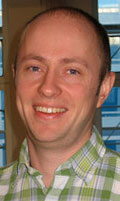 PhD
candidate Mattias von Brömssen
(photo) has been engaged in a doctoral project, Options
for safe drinking water in regions with high-arsenic groundwater in Bangladesh, funded by Sida/SAREC.
His supervisors in the project are Prosun Bhattacharya, Gunnar Jacks and
Kazi Matin
Uddin Ahmed (Bangladesh), Department of Geology, Dhaka University,
Bangladesh.
In November 2005 this project received SEK 1.2 Million from Sida/SAREC
for a two years period (2006-07). More
information on Sida funded South Asia related research projects in 2005.
PhD
candidate Mattias von Brömssen
(photo) has been engaged in a doctoral project, Options
for safe drinking water in regions with high-arsenic groundwater in Bangladesh, funded by Sida/SAREC.
His supervisors in the project are Prosun Bhattacharya, Gunnar Jacks and
Kazi Matin
Uddin Ahmed (Bangladesh), Department of Geology, Dhaka University,
Bangladesh.
In November 2005 this project received SEK 1.2 Million from Sida/SAREC
for a two years period (2006-07). More
information on Sida funded South Asia related research projects in 2005.
Mattias von Brömssen is currently working for Ramböll Sweden in Stockholm, at its Department for Water Resources Management. ![]()
Md.
Jakariya from BRAC Arsenic Mitigation Project,
Bangladesh Rural Advancement Committee (BRAC) in Dhaka, Bangladesh,
was doing his PhD at the department, supervised by Prosun
Bhattacharya. He defended his doctoral dissertation
titled ”Arsenic
in Tubewell Water of Bangladesh, and Approaches for Sustainable
Mitigation” on Thursday 24 May 2007. The faculty opponent was Prof. Jan
Hoinkis, University
of Applied Sciences in Karlsruhe, Germany. The thesis dwells on the central
issue of devising different strategies for As mitigation and to
find their sustainability and rational distribution to the affected
population and to meet the safe water target of the Millennium
Development Goal (MDG). Importantly, the issues identified in the
thesis for further research will develop common global approaches
for sustainable mitigation and management of As in drinking water.
Read
the full dissertation (as a pdf-file)
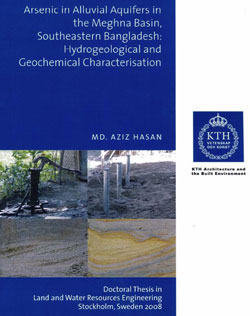 Md. Aziz Hasan from the Dept. of Geology, University of Dhaka, has also done a PhD at the department, supervised by Prosun Bhattacharya. He defended his doctoral l dissertation titled ”Arsenic in alluvial aquifers in the Meghna basin, South-Eastern Bangladesh: Hydrogeological and geochemical characterisation” on Wednesday 5 November 2008. The study reveals that the local and regional scale variations in groundwater composition, levels
of As concentrations and the redox conditions are governed by the geological attributes of the
aquifers. Groundwater in the grey to dark grey argillaceous sediments where organic matter and
micas are abundant contain high concentration of dissolved As.
High concentrations of As and salinity are the major constraints for groundwater development in
the Holocene alluvial aquifers of the Meghna basin.
Abstraction of groundwater from the Holocene deeper low-As aquifers for drinking purposes
should thus be be properly guided to minimise the risk of cross-contamination and installation of
high-capacity irrigation wells in the deeper aquifers must be avoided for sustainable drinking
water supplies. Read
the full dissertation (as a pdf-file).
Md. Aziz Hasan from the Dept. of Geology, University of Dhaka, has also done a PhD at the department, supervised by Prosun Bhattacharya. He defended his doctoral l dissertation titled ”Arsenic in alluvial aquifers in the Meghna basin, South-Eastern Bangladesh: Hydrogeological and geochemical characterisation” on Wednesday 5 November 2008. The study reveals that the local and regional scale variations in groundwater composition, levels
of As concentrations and the redox conditions are governed by the geological attributes of the
aquifers. Groundwater in the grey to dark grey argillaceous sediments where organic matter and
micas are abundant contain high concentration of dissolved As.
High concentrations of As and salinity are the major constraints for groundwater development in
the Holocene alluvial aquifers of the Meghna basin.
Abstraction of groundwater from the Holocene deeper low-As aquifers for drinking purposes
should thus be be properly guided to minimise the risk of cross-contamination and installation of
high-capacity irrigation wells in the deeper aquifers must be avoided for sustainable drinking
water supplies. Read
the full dissertation (as a pdf-file).
Currently, PhD candidate Mohammed Hossain Tipu from the University of Dhaka, carries out research at the department, also supervised by Prosun Bhattacharya. Mr. Hossain is working for the NGO Forum in Bangladesh, and is national coordinator for the Sustainable Arsenic Mitigation (SASMIT) project research project, mentioned above.
On 15 June 2009, SASNET’s Anna Lindberg and Lars Eklund visited the department. They were able to meet a few of the guest researchers and students from South Asia that reularly stay at the department, including Mr. Hossain Tipu. They also met the Linnaeus Palme exchange programme scholarship students Sarmin Sultana and Mokleksur Rahman, both from the University of Dhaka, Bangladesh. Read the report from Anna’s and Lars’ visit to KTH. (Photo, see above)![]()
In 2004, the two undergraduate students Linda Jonsson and Lisa Lundell made a Minor Field Study on ”Targeting safe aquifers in regions with arsenic-rich groundwater in Bangladesh: Case-study in Matlab Upazila”, published by the Swedish University of Agricultural Sciences (SLU). They were supervised by Gunnar Jacks and Mattias von Brömssen from the department, but also by Kazi Matin Uddin Ahmed, Dhaka University, and Md. Jakariya from BRAC Arsenic Mitigation Project. Go for Linda Jonsson’s and Lisa Lundell’s MFS paper (as a pdf-file)
Other South Asia related research projects at the department:
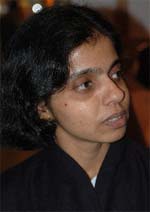 Research
scientist Nandita
Singh, is involved in a project on “Problems
and Prospects of Sustainable Water Resources Management in India: An Insight
from Gender Perspective”. The project focuses on
the issue of water in the now severely water-stressed Indian state of
Gujarat, where the seriousness of the problem warrants its exploration
not only from the gender perspective but essentially also as a human rights
concern. The problems encountered by the local communities in the northern
part of the state are unique in combining deficiency of water with high
fluoride rates in drinking water, resulting in concomitant gender and
socio-economically disaggregated impacts on their lives. Additional research
projects will be designed in the future so as to enable research on the
remaining issues of concern.
Research
scientist Nandita
Singh, is involved in a project on “Problems
and Prospects of Sustainable Water Resources Management in India: An Insight
from Gender Perspective”. The project focuses on
the issue of water in the now severely water-stressed Indian state of
Gujarat, where the seriousness of the problem warrants its exploration
not only from the gender perspective but essentially also as a human rights
concern. The problems encountered by the local communities in the northern
part of the state are unique in combining deficiency of water with high
fluoride rates in drinking water, resulting in concomitant gender and
socio-economically disaggregated impacts on their lives. Additional research
projects will be designed in the future so as to enable research on the
remaining issues of concern.
Partners in the project are (in Sweden) Prosun
Bhattacharya and Jan-Erik Gustafsson,
and (in India) Professor Jayanto Bandopadhyay,
Centre for Development and Environment Policy, India Institute of Management,
Kolkata, and Research Associate Vishar Narain,
Resource and Development Economics, Policy Analysis Division, Tata Energy
Research Institute, New Delhi. Nandita Singh received a SASNET
planning grant from SASNET in January 2003 for this project. Preliminary
findings emerging from the planning visit to the field in 2003 enabled
Singh to formulate two research papers presented at the 18th European
Conference on Modern South Asian Studies held in Lund 6–9 July 2004.
In recent years she has also worked on two similar research project on
women and gender in India: One on ”Women and
water: Need for a holistic and sustainable policy” (funded
by the Wenner-Gren Foundation 2002-04), and another one on ”Women
and Water: Encountering the challenges of water resource management in
rural India from gender perspective” (funded by Sida/SAREC
2003-05).
In August 2005 Nandita Singh again received a
SASNET planning grant for an interdisciplinary research project related
to the issue of sustainable water management in India. More
information on the August 2005 SASNET grants.
The new project is named ”Relevance
of socio-cultural context in realization of the human right to water in
India: An insight from gender perspective”, and
will be planned for in collaboration with the Department
of Sociology of Law, Lund University (contact persons Professor Prof.
Karsten Åstrom, Professor Håkan
Hydén, and Associate Professor Per
Wickenberg); the National Institute of Human Rights at National
Law School of India University in Bangalore, India (contact person: Sarasu
E. Thomas, Coordinator); and SEWA Academy (Self-Employed Women’s
Association), SEWA, Ahmedabad, India (contact person: Namrata
Bali, General Secretary).
In November 2005 Nandita Singh also received SEK 500 000 as a one-year
grant from Sida/SAREC for this project.
Abstract of project: The right to water is an important
human right within the category of economic, social & cultural rights
where special attention is paid to women as a group traditionally facing
difficulties in exercising the right. However, large-scale violations
of the right are reported to persist in the developing world, India being
a significant case where despite positive actions by the state towards
its protection & fulfilment with focus on women, a substantial number
of them are unable to enjoy the right effectively. This planning project
will explore the hypothesis that the origin of the problem lies in factors
embedded within the socio-cultural context of the women, that play a critical
role at the ‘third’ level of implementation of human rights
law - at the ‘interface’ between the state and the local actors.
An understanding of the nature of the factors is aimed to be developed
through the planning exercise, coupled with identification of micro-level
specificities in this connection through joint planning exercises with
the partners in India who have knowledge and experience in relation to
human rights and women’s development. An interdisciplinary insight
on the problem, based in Anthropology and Sociology of Law, is expected
to enable more comprehensive understanding and interpretation as well
as facilitate formulation of an integrated strategy for overcoming the
barriers in the Indian context that will constitute the final objective
of the proposed research.
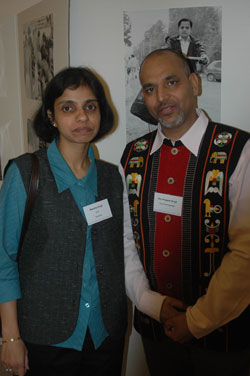 At the Sida-funded conference on current Swedish development research titled ”Meeting Global Challenges in Research Cooperation” that was jointly organised by Uppsala University and the Swedish University of Agricultural Sciences (SLU) in Uppsala 27-29 May 2008 (more information), Dr. Singh presented the project in a panel on ”Water and Sanitation”. Her paper was titled ”Meeting the MDGs through the Human Right to Water – A gendered analysis in India from
actor oriented perspective”. She also presented a photo exhibition along with her husband, Mr. Om Prakash Singh (seen on the photo to the right), on the water problems the citizens of Delhi face. The exhibition was titled ”Human Right to Water – Reality or a Fantasy?”
At the Sida-funded conference on current Swedish development research titled ”Meeting Global Challenges in Research Cooperation” that was jointly organised by Uppsala University and the Swedish University of Agricultural Sciences (SLU) in Uppsala 27-29 May 2008 (more information), Dr. Singh presented the project in a panel on ”Water and Sanitation”. Her paper was titled ”Meeting the MDGs through the Human Right to Water – A gendered analysis in India from
actor oriented perspective”. She also presented a photo exhibition along with her husband, Mr. Om Prakash Singh (seen on the photo to the right), on the water problems the citizens of Delhi face. The exhibition was titled ”Human Right to Water – Reality or a Fantasy?”
Abstract: One of the targets of the UN Millennium Development Goals (MDGs) is to halve the number of
people without sustainable access to safe drinking water by 2015. It is believed that one of the
ways to add impetus to the ongoing efforts is to explicitly recognize water as a ‘human right’, with
a focus on ensuring the right of women and children, who are seen to be the worst sufferers from
lack of sustainable water access. It is assumed that focus on the human right to water (HRW)
would serve as a means to increase the pressure on governments and international agencies to
translate the right into specific national and international legal obligations and responsibilities,
thus paving the way for ensuring water access for all (UNESCO, 2006).
This assumption has been examined by the authors within the scope of two different research
projects supported by Sida-Sarec. Using an actor-oriented perspective that further made a
distinction between ‘implementation’ and ‘realization’ of human rights, these projects attempt to
understand how the globally formulated norms concerning water as a human right get translated
into action at the local level. The first project looked at the HRW of women while the second one
focuses on the right of children. The research is based upon empirical studies in different parts of
India and refers to the right to water situation in areas affected by problems of water quality and
quantity.
The findings of the research indicate that realization of HRW essentially involves dynamics at the
‘third level’ of human rights implementation. This constitutes the interface between the
community and the agency where action towards fulfillment of the right is ultimately unfolded.
Following the rights-based approach to development, two kinds of actors were identified – the ‘rights-holders’ (women and children) and the ‘duty-bearers’ (government, NGOs, international
development agencies). The contextual factors that influence the realization of the HRW of
women and children as separate right-holder groups can be classified into two categories: first,
the nature of human rights approach adopted by the agency (if any) and second, the socio-cultural
factors in the community context that lead to re-construction of the right at the local level. The
dynamics of interaction between the two sets of factors are complex and need to be understood as
contextual realities. On the whole, the latter have been found to have significant influence on the
equitable, effective and sustainable realization of the HRW.
From the preliminary findings of the research, it can be concluded that mere legislative actions at
international and national forums for implementing the HRW may not offer enough benefits
towards ensuring progress towards the MDGs. There is a need to explore the dynamics at the‘third’ level and consider how the learnings can be integrated into the global and state initiatives
so as to promote water justice for women and children.
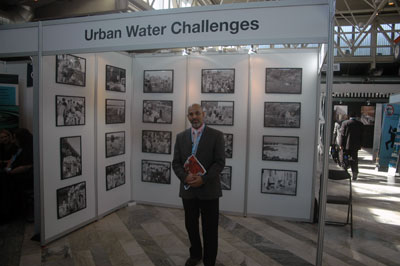 |
| Mr. Om Prakash Singh in front of the photo-exhibition at the 2008 World Water Week in Stockholm. |
During the World Water Week 16-23 August 2008, Dr. Nandita Singh, along with her husband, Mr. Om Prakash Singh who is a visual anthropologist, presented a photo-exhibition titled ‘Urban Water Challenges’. The exhibition – that turned out to be one of the most highly visited stalls at the Week – was supported by the Swedish Water House. It displayed large-sized black and white photographs portraying the looming water crisis in Delhi both in terms of quantity and quality. Aimed at sensitising the various stakeholders who share a concern with water – the policy-makers, planners, other development actors and the research community – each photograph depicted a significant theme, including water corruption, gender sensitivity, gender equality, water conflicts, water pollution, children and water, sanitation and water scarcity.
Dr. Singh was also an invited speaker at the Seminar on the Right to Water and Sanitation – Approaches and Practical Implications, convened by SIWI, UNDP, Swedish water House, COHRE, SIDA and UN-Habitat. Her presentation, titled ‘Role of socio-cultural context in realization of the Right in India’, outlined the findings of her research on the right of women and children to water in India, carried out in collaboration with partners at the Division of Sociology of Law, Lund University and supported by Sida-Sarec.
Dr. Singh also presented a paper in the Workshop on ‘The lingering failure of sanitation-Why? Her paper titled ‘Total sanitation efforts in India: Problems and prospects’ invited wide attention as it highlighted the importance of looking at sanitation as an issue of ‘behavioural change’ that cannot be addressed through mere installation of sanitary infrastructure and counting of numerical targets.
On 19th September 2008, Dr. Singh, along with Prof. Karsten Åström from the Division of Sociology of Law, LU, have been invited to make a presentation at the Social Sciences Day Seminar on “Conflicts around Water: Struggle about our most important resource” organised by Lund University. Their presentation will be on the topic ‘Human right to water in India: Problems and prospects’ where using an actor-oriented perspective, the process of ‘realization’ of the right at the micro-level will be seen as influenced by two sets of contextual factors at the ‘interface’ between the duty-bearers and the right-holders, these being embedded in the implementation context introduced by the former and the socio-cultural context lived in by the latter.
Dr. Nandita Singh is responsible for 7,5 credits course titled ”Gender issues in Developing Countries” that was first held in the Fall 2007. The course aims at imparting integrated theoretical and practical knowledge on gender and development issues in the South to students, researchers, teachers and development practitioners in different kinds of agencies in Sweden. More information.
Professor Vladimir Cvetkovic is also working on an India related research project. In
November 2007, he was given SEK 1.2 million as a three-years grant (2008-10) from Sida's
Developing Country Research Council (U-landsforskningsrådet), for a project titled ”Assessing groundwater vulnerability and risks from on-site
sanitation - General method development and case study”. More information about the Sida grants 2007.
Prof. Cvetkovic has been involved in collaboration with the Centre for Water Resources Development and Management (CWRDM) in Kozhikode, one among the R&D institutes of the Kerala State Council for Science, Technology and Environment (KSCTE). In 2005, Dr. P.S. Harikumar from the Chemical Sciences division of CWRDM visited Sweden, and was a visiting scientist working at KTH with Prof. Cvetcovic.
Conferences/workshops, radio programme and book project:
The KTH-International Groundwater Arsenic Research Group (GARG) is
regularly engaged in International conferences, symposia and
workshops, see a list on http://www.lwr.kth.se/Personal/personer/bhattacharya_prosun//Garg/conferences.htm
The 2nd KTH-Dhaka University International
Seminar on Natural Arsenic in Groundwater of South Asia (NAGSA-2005) was held in Dhaka, Bangladesh, in December 2005.
The conference was jointly organized by Department of Geology,
Dhaka University and GARG.
In February 2006, GARG was involved in organising an International Conference on ”Groundwater for Sustainable Development:
Problems, Perspectives and Challenges”
(IGC-2006) in collaboration with the School of Environmental Sciences,
Jawaharlal Nehru University
(JNU), New Delhi, India, and other partners. The conference was held at
India International Center in New Delhi. More information.
On Wednesday 16 February 2005 the Swedish Radio
Channel 1/Vetenskapsradion broadcasted a programme on the Arsenic
contamination of groundwater in Bangladesh. The programme was called ”Arsenik
i grund och botten”, and was based upon interviews with Prosun
Bhattacharya, and Professor Marie Vahter from the Division
of Metals & Health, Institute of Environmental Medicine; Karolinska
Institutet , Stockholm.
Full information on the programme (in Swedish only). Here is also
a link to listen to the programme through web radio.
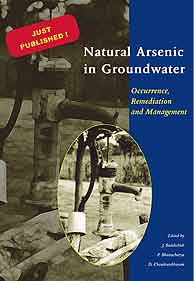 In 2005, Prosun
Bhattacharya edited a new book on “Natural
Arsenic in Groundwater: Occurrence, Remediation and Management” , together with Jochen
Bundschuh (ICE, Costa Rica/Universidad Nacional de Santiago del
Estero and UNSE, Argentina); and D. Chandrashekharam (IIT Mumbai, India). The book, published by Taylor & Francis Group, London, was officially
released at a function in connection with an India evening at KTH in Stockholm
on 16 March 2005. The book comprises 35 scientific contributions, based
on the papers presented at the Pre-Congress Workshop
(BWo 06) on Natural Arsenic in Groundwater organized by the authors
during the 32nd International Geologial Congress at Florence, Italy 18–19
August 2004. The publication is an important landmark in its aim of bridging
the gap between the researchers’ knowledge about the occurrence
of arsenic in groundwater and the underlying mechanisms for its mobilization,
remediation as well as a thought provoking challenges for the management
of the arsenic problem for the sustainable development of our society.
In 2005, Prosun
Bhattacharya edited a new book on “Natural
Arsenic in Groundwater: Occurrence, Remediation and Management” , together with Jochen
Bundschuh (ICE, Costa Rica/Universidad Nacional de Santiago del
Estero and UNSE, Argentina); and D. Chandrashekharam (IIT Mumbai, India). The book, published by Taylor & Francis Group, London, was officially
released at a function in connection with an India evening at KTH in Stockholm
on 16 March 2005. The book comprises 35 scientific contributions, based
on the papers presented at the Pre-Congress Workshop
(BWo 06) on Natural Arsenic in Groundwater organized by the authors
during the 32nd International Geologial Congress at Florence, Italy 18–19
August 2004. The publication is an important landmark in its aim of bridging
the gap between the researchers’ knowledge about the occurrence
of arsenic in groundwater and the underlying mechanisms for its mobilization,
remediation as well as a thought provoking challenges for the management
of the arsenic problem for the sustainable development of our society.
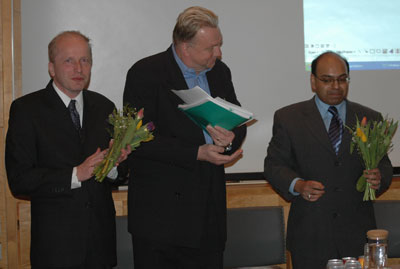 The
book release was officiated by Professor Anders
Flodstöm, the President of KTH (on the photo to the right
Flodström presents two of the book editors, Bundschuh and Bhattacharya,
with flowers as thanks).
The
book release was officiated by Professor Anders
Flodstöm, the President of KTH (on the photo to the right
Flodström presents two of the book editors, Bundschuh and Bhattacharya,
with flowers as thanks).
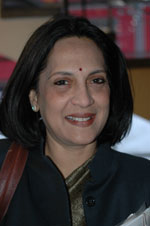 It was
extended to be an India Evening, attended by among others the new Ambassador
of India to Sweden, Deepa Gopalan Wadhwa
(photo to the left).
It was
extended to be an India Evening, attended by among others the new Ambassador
of India to Sweden, Deepa Gopalan Wadhwa
(photo to the left).
She gave a speech on ”Challenges for safe drinking water in
India – Achievement of the Millennium Development Goals”.
The ambassador of Bangladesh, Mr. Sabihuddin Ahmed,
was also a chief guest at the function.
Prof. Emeritus Gunnar Jacks lectured on ”A walk through the
past – Our Experiences with Groundwater Resources in India”,
about the 30 years of Indo-Swedish interaction between the department
and the Tamil Nadu Agricultural University in Coimbatore, whereas Ramon
Wyss, the Vice-President of KTH in charge of International Affairs,
talked about ”Prospects of Indo-Swedish collaborations”,
focusing on ongoing efforts to increase research cooperation between KTH
and Indian institutions.
Staffan Lindberg and Lars Eklund from SASNET were also present at the
function, and Prof. Lindberg was given the opportunity to present SASNET’s
activities for the audience.
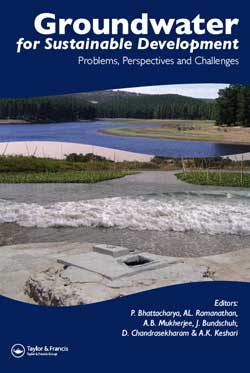 On Friday 18 April 2008, a new book project, “Groundwater for Sustainable Development: Problems, Perspectives and Challenges”, was launched by KTH through its International Groundwater Arsenic Research Group (GARG), Department of Land and Water Resources Engineering; and the International Society of Groundwater for Sustainable Development (ISGSD). The book has been dedicated to Prof. Emeritus Gunnar Jacks.
On Friday 18 April 2008, a new book project, “Groundwater for Sustainable Development: Problems, Perspectives and Challenges”, was launched by KTH through its International Groundwater Arsenic Research Group (GARG), Department of Land and Water Resources Engineering; and the International Society of Groundwater for Sustainable Development (ISGSD). The book has been dedicated to Prof. Emeritus Gunnar Jacks.
The volume is based on papers presented at the International conference held in New Delhi in February 2006 (see above), and it has been edited by Prosun Bhattacharya (KTH, Stockholm), AL. Ramanathan (JNU, New Delhi) , Arun B. Mukherjee (University of Helsinki, Finland), Jochen Bundschuh (ICE,Costa Rica), D. Chandrashekharam (IIT Bombay, India) and Ashok K. Keshari (IIT Delhi, India) and published by Taylor & Francis Group plc, London, UK.
A colloquium on Groundwater for Sustainable Development was held on the occasion of the book launch. Gunnar Jacks talked about ”Visions on Sustainable Development of Groundwater Resources in Developing Countries”; Prof. Ramon Wyss (Advisor to the KTH President) talked about ”Current initiatives on Indo-Swedish collaborations – the INSTEC Platform”; Prof. Bjorn Hårsman (Dean, School of Architecture and Built Environment, KTH), talked about ”Groundwater Resources in Built Environment and Sustainability”; and Prof. Hans Lundberg (IVL) talked about ”Sustainable Urban Development in Developing Countries”. Venue: KTH, Styrelserummet, Valhallavägen 79, Stockholm. More information about the book launch and the colloquium.
SASNET - Swedish South Asian Studies Network/Lund
University
Address: Scheelevägen 15 D, SE-223 70 Lund, Sweden
Phone: +46 46 222 73 40
Webmaster: Lars Eklund
Last updated
2011-01-19
